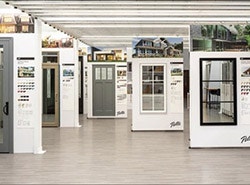Custom Windows Bring Nature Center’s Vision to Life
A variety of windows offer sustainability and style in St. Louis Park nature center.
Project Details
Type:
Commercial New Construction
Building Type:
Community
Location:
St. Louis Park, MN
Architect:
Hammel, Green and Abrahamson (HGA)
Products Used:
Pella’s commitment to innovation and sustainability shines through in our collaboration with HGA on the Westwood Hills Nature Center project in St. Louis Park, Minnesota. This net-zero energy building showcases how Pella's high-performance windows and doors can contribute to the unique needs of stylistic appeal and environmental responsibility projects like this require.
Casement Windows and Picture Windows Blend Form with Function
The Westwood Hills Nature Center required windows that could seamlessly integrate with its natural surroundings while meeting stringent energy efficiency standards. Pella Reserve — Traditional casement and picture windows were the perfect solution. These windows provide expansive views of the surrounding woodland and illuminate the interior with natural light, while also contributing to the building's energy performance.
The casement windows offer excellent ventilation control, allowing for natural air circulation throughout the building. This natural airflow can reduce the need for additional interior climate control, helping to reduce the energy usage of the building. The picture windows maximize natural light, minimizing the need for artificial lighting during daylight hours and further contributing to the building's energy efficiency goals.
Awning Windows Offer Versatility and Performance
To complement the casement and picture windows, we installed Pella Reserve — Traditional awning windows. These windows provide additional ventilation options, even during light rain, making them ideal for Minnesota's varied climate. The outward swing of awning windows allows for customizable airflow and precise control over ventilation, offering flexibility to fine-tune the indoor environment based on weather conditions and occupancy.
Custom Window Solutions: The Key to Bird Safety
One of the most unique challenges of this project was the need for bird-safe glass to protect the local wildlife around the building. Bird-safe glass displays a pattern that alerts birds to the presence of an obstacle and prevents bird strikes on the building. We used two types of bird-safe glass: Viracon Medium Gray Tint tempered glass with our custom fret pattern and Ornilux N10 tempered glass. This addressed the goal of protecting local birds from the structure while maintaining the stylistic choice of floor-to-ceiling windows.
Pella’s team collaborated closely with HGA and the National Audubon Society to consider their recommendations, and then coordinated with both HGA and our general contractor RJM to custom design a horizontal line fret pattern for our windows. To maintain an elegant and cohesive look, we worked meticulously to make sure all horizontal lines matched up evenly throughout the building’s elevations.
Glass Hinged Doors Bridge the Indoors and Outdoors
For the Nature Center's entrances and exits, we installed Pella Reserve — Traditional commercial doors. The hinged design allows for a tighter seal against the elements, contributing to the Center's overall energy efficiency. The glass doors play a crucial role in connecting the interior spaces with the surrounding nature. These commercial hinged doors not only provide clear views and abundant natural light but also incorporate the same bird-safe technology as the windows.
The success of the Westwood Hills Nature Center project, evidenced by its Zero Energy Certification from the International Living Future Institute, showcases how thoughtful product choices and custom solutions like bird-safe glass can contribute to achieving ambitious sustainability goals.
And, after being open for just a couple years, the building recently reached its goal of obtaining the Zero Energy Certification from the International Living Future Institute (IFLI). The Net Zero Energy Certification just confirms that the building truly is living up to its high energy performance standards by “harnessing energy from the sun, wind or earth to produce net annual energy demand.”
That means the Westwood Hills Nature Center is 100% self-sustained when it comes to energy use. And in Minnesota’s cold winter climate, that’s a huge accomplishment.


